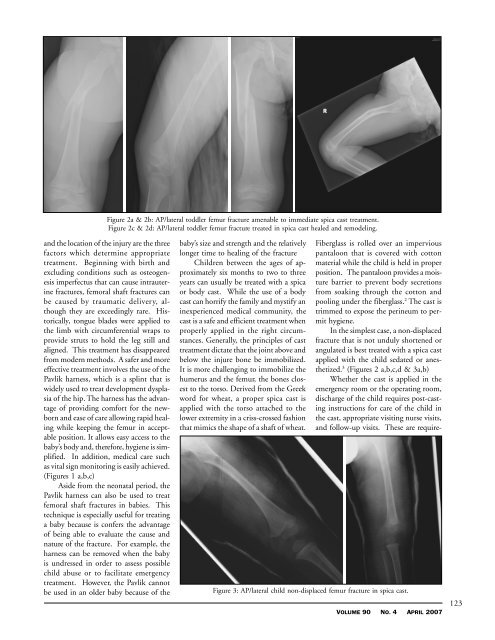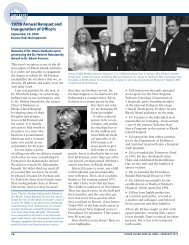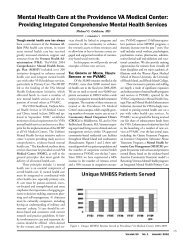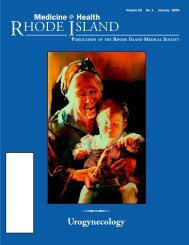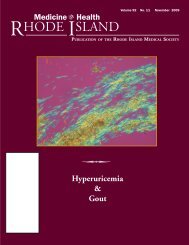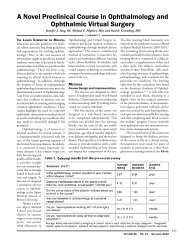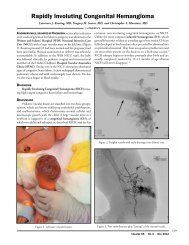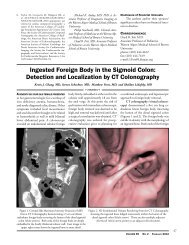April 2007 - Division of Biology and Medicine - Brown University
April 2007 - Division of Biology and Medicine - Brown University
April 2007 - Division of Biology and Medicine - Brown University
You also want an ePaper? Increase the reach of your titles
YUMPU automatically turns print PDFs into web optimized ePapers that Google loves.
Figure 2a & 2b: AP/lateral toddler femur fracture amenable to immediate spica cast treatment.<br />
Figure 2c & 2d: AP/lateral toddler femur fracture treated in spica cast healed <strong>and</strong> remodeling.<br />
<strong>and</strong> the location <strong>of</strong> the injury are the three<br />
factors which determine appropriate<br />
treatment. Beginning with birth <strong>and</strong><br />
excluding conditions such as osteogenesis<br />
imperfectus that can cause intrauterine<br />
fractures, femoral shaft fractures can<br />
be caused by traumatic delivery, although<br />
they are exceedingly rare. Historically,<br />
tongue blades were applied to<br />
the limb with circumferential wraps to<br />
provide struts to hold the leg still <strong>and</strong><br />
aligned. This treatment has disappeared<br />
from modern methods. A safer <strong>and</strong> more<br />
effective treatment involves the use <strong>of</strong> the<br />
Pavlik harness, which is a splint that is<br />
widely used to treat development dysplasia<br />
<strong>of</strong> the hip. The harness has the advantage<br />
<strong>of</strong> providing comfort for the newborn<br />
<strong>and</strong> ease <strong>of</strong> care allowing rapid healing<br />
while keeping the femur in acceptable<br />
position. It allows easy access to the<br />
baby’s body <strong>and</strong>, therefore, hygiene is simplified.<br />
In addition, medical care such<br />
as vital sign monitoring is easily achieved.<br />
(Figures 1 a,b,c)<br />
Aside from the neonatal period, the<br />
Pavlik harness can also be used to treat<br />
femoral shaft fractures in babies. This<br />
technique is especially useful for treating<br />
a baby because is confers the advantage<br />
<strong>of</strong> being able to evaluate the cause <strong>and</strong><br />
nature <strong>of</strong> the fracture. For example, the<br />
harness can be removed when the baby<br />
is undressed in order to assess possible<br />
child abuse or to facilitate emergency<br />
treatment. However, the Pavlik cannot<br />
be used in an older baby because <strong>of</strong> the<br />
baby’s size <strong>and</strong> strength <strong>and</strong> the relatively<br />
longer time to healing <strong>of</strong> the fracture<br />
Children between the ages <strong>of</strong> approximately<br />
six months to two to three<br />
years can usually be treated with a spica<br />
or body cast. While the use <strong>of</strong> a body<br />
cast can horrify the family <strong>and</strong> mystify an<br />
inexperienced medical community, the<br />
cast is a safe <strong>and</strong> efficient treatment when<br />
properly applied in the right circumstances.<br />
Generally, the principles <strong>of</strong> cast<br />
treatment dictate that the joint above <strong>and</strong><br />
below the injure bone be immobilized.<br />
It is more challenging to immobilize the<br />
humerus <strong>and</strong> the femur, the bones closest<br />
to the torso. Derived from the Greek<br />
word for wheat, a proper spica cast is<br />
applied with the torso attached to the<br />
lower extremity in a criss-crossed fashion<br />
that mimics the shape <strong>of</strong> a shaft <strong>of</strong> wheat.<br />
Fiberglass is rolled over an impervious<br />
pantaloon that is covered with cotton<br />
material while the child is held in proper<br />
position. The pantaloon provides a moisture<br />
barrier to prevent body secretions<br />
from soaking through the cotton <strong>and</strong><br />
pooling under the fiberglass. 2 The cast is<br />
trimmed to expose the perineum to permit<br />
hygiene.<br />
In the simplest case, a non-displaced<br />
fracture that is not unduly shortened or<br />
angulated is best treated with a spica cast<br />
applied with the child sedated or anesthetized.<br />
3 (Figures 2 a,b,c,d & 3a,b)<br />
Whether the cast is applied in the<br />
emergency room or the operating room,<br />
discharge <strong>of</strong> the child requires post-casting<br />
instructions for care <strong>of</strong> the child in<br />
the cast, appropriate visiting nurse visits,<br />
<strong>and</strong> follow-up visits. These are require-<br />
Figure 3: AP/lateral child non-displaced femur fracture in spica cast.<br />
VOLUME 90 NO. 4 APRIL <strong>2007</strong><br />
123


